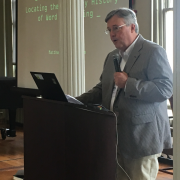 The term “digital humanities” (or “DH”) refers to computer-assisted scholarship in all areas of the humanities, and to critical and theoretical reflections on digital media and methods. Often interdisciplinary and collaborative, it goes beyond routine use of computers in research and the classroom, testing the potential of computational methods to advance a specific inquiry in ways not otherwise feasible. DH investigations address questions and weigh evidence appropriate to humanities disciplines, from philosophy and ethics to the history of language, from aesthetics to world cultures and social justice.
The term “digital humanities” (or “DH”) refers to computer-assisted scholarship in all areas of the humanities, and to critical and theoretical reflections on digital media and methods. Often interdisciplinary and collaborative, it goes beyond routine use of computers in research and the classroom, testing the potential of computational methods to advance a specific inquiry in ways not otherwise feasible. DH investigations address questions and weigh evidence appropriate to humanities disciplines, from philosophy and ethics to the history of language, from aesthetics to world cultures and social justice.
At UVa, digital humanists pursue research and teaching in many subjects, including art and architecture, history, literary and language study, and the interpretive social sciences. Some projects assemble interactive exhibits, archives, maps, or virtual sites to take advantage of online visualizations and provide access to large sets of data. Some projects catalogue and share oral histories, others analyze historical social networks, and still others build databases of artifacts from art history or archeology. Other strengths at UVA lie in photogrammetry of cultural heritage sites such as the Lawn, large-scale histories such as the Civil War, and bibliographies of printed books or documents. Some practitioners at UVA develop algorithms to analyze digitized texts, and others collaborate with students on annotated, authoritative online editions of literary works.
DH Examples: Humanists from many departments at UVa have implemented innovative digital approaches to their own subject areas in collaboration with computer scientists and technologists. This history of practical success will serve as a foundation for graduate student recruitment and education. For example, Collective Biographies of Women (CBW)—an ongoing, NEH-funded project arising from the collaboration of an English department faculty member with computational experts at two of UVa’s DH units as well as graduate student research teams—utilizes database and XML markup technologies to produce new insights into short-form biographical narratives of women. Another example is Jefferson’s University…the early life (JUEL), which combines the expertise of faculty from the history, computer science, art history, and architectural history departments, has employed a large number of graduate research assistants, and depends on 3D modeling and database technologies to provide insights into the day-to-workings of the Academical Village in its early years. A further example is the Tibetan Himalayan Library, which originated at UVa in 2000 as a collaboration between a religious studies professor, the Library, and a DH unit, and now promotes the global, interdisciplinary integration of knowledge and communities of expertise about the Tibetan plateau and southern Himalayan regions. For further examples of UVa’s DH projects, see the IATH project list and the Scholars’ Lab project list.
-- Co-authored by John Unsworth, Alison Booth, Rafael Alvarado, and Rennie Mapp
